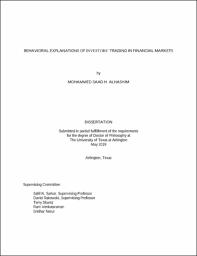
ATTENTION: The works hosted here are being migrated to a new repository that will consolidate resources, improve discoverability, and better show UTA's research impact on the global community. We will update authors as the migration progresses. Please see MavMatrix for more information.
Show simple item record
| dc.contributor.advisor | Sarkar, Salil K | |
| dc.contributor.advisor | Rakowski, David | |
| dc.creator | Alhashim, Mohammed Saad H | |
| dc.date.accessioned | 2021-06-03T19:01:15Z | |
| dc.date.available | 2021-06-03T19:01:15Z | |
| dc.date.created | 2019-05 | |
| dc.date.issued | 2019-05-03 | |
| dc.date.submitted | May 2019 | |
| dc.identifier.uri | http://hdl.handle.net/10106/29880 | |
| dc.description.abstract | In the first essay, I examine the effect of social media sentiment on the trading behavior of individual investors. I document a positive association between sentiment and retail order imbalances (i.e., individual investors tend to buy more than they sell as they become more optimistic about stocks). The association between retail investor activity and sentiment is stronger for hard-to-value stocks (small cap, low institutional ownership, and low analyst coverage firms). Finally, the association between retail order imbalances and stock returns exists only in conjunction with investor sentiment.
In the second essay, I consider the effect of firm-level sentiment extracted from a social network platform on the presence of herding behavior in the US equity market. Applying a quantile regression model enables me to investigate the existence of herding during both quiet periods and extreme market movements. I also benefit from using different sampling frequencies (daily, weekly, and monthly) for detecting investor herding. I document an asymmetric association between herding and investor sentiment. Herding is present in low-optimism portfolios but not in high-optimism portfolios. I also find evidence of herding in intermediate quantiles (i.e., relatively quiet market periods but not during extreme market movements). The degree of investor attention has a moderating impact on the relationship between investor optimism and the tendency to herd, with herding being more intense among low-optimism stocks. I also find evidence that trading volume drives herding behavior.
In the third essay, I estimate the impact of investor sentiment in the stock market on the return and volatility spillover risks between real estate investment trusts (REITs) and a broader equity index. The total return spillover risk from equity market to real estate is higher for low-optimism portfolios (45.76%) relative to high-optimism portfolios (41.41%). I do not document any significant impact of investor sentiment on the volatility spillover risk between REITs and the equity market (34.85% versus 34.17%). My results highlight the importance of considering investor sentiment in the stock market when constructing multi-asset portfolios that include REITs in addition to other asset classes. | |
| dc.format.mimetype | application/pdf | |
| dc.language.iso | en_US | |
| dc.subject | Investor sentiment | |
| dc.subject | Herding behavior | |
| dc.subject | Spillover risk | |
| dc.title | BEHAVIORAL EXPLANATIONS OF INVESTORS’ TRADING IN FINANCIAL MARKETS | |
| dc.type | Thesis | |
| dc.degree.department | Finance | |
| dc.degree.name | Doctor of Philosophy in Business Administration | |
| dc.date.updated | 2021-06-03T19:01:16Z | |
| thesis.degree.department | Finance | |
| thesis.degree.grantor | The University of Texas at Arlington | |
| thesis.degree.level | Doctoral | |
| thesis.degree.name | Doctor of Philosophy in Business Administration | |
| dc.type.material | text | |
| dc.creator.orcid | 0000-0002-3201-4680 | |
Files in this item
- Name:
- ALHASHIM-DISSERTATION-2019.pdf
- Size:
- 1.641Mb
- Format:
- PDF
This item appears in the following Collection(s)
Show simple item record


